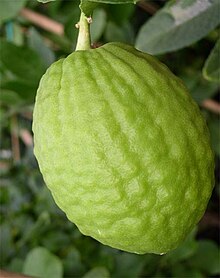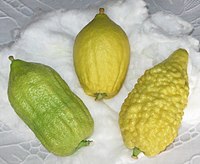Corsican citron
This article includes a list of general references, but it lacks sufficient corresponding inline citations. (May 2015) |

| Citron varieties |
|---|
 |
| Acidic-pulp varieties |
| Non-acidic varieties |
| Pulpless varieties |
| Citron hybrids |
| Related articles |
The Corsican citron (called alimea in Corsican and cedrat in French) is a citron variety that contains a non-acidic pulp.
The name is from its most original cultivation center which is even today, at the French Island of Corsica or Corse. It is said to be one of the first citrus fruit to reach the Corsican soil.[1]
History, production and uses[edit]
Traditionally, it was one of the most important varieties employed in Succade production. The fruit used to be shipped to Genoa, Italy, where it was de-pulped in the large centers in Livorno, hence its name the Citron of Commerce.[citation needed]
With 45,000 tons per year, Corsica was once the world's leading producer of citron. The historian Laurence Pinelli explains:[1]
Citron was a source of considerable wealth for Corsica. It shaped the landscape, added a great deal to our culinary heritage and boosted the island's economy considerably.
Etrog[edit]
For a short period of time Genoese merchants, who always supplied fruit for the Jewish ritual of Etrog, used to ship also some amount of this Corsican variety, while there was not enough available from Diamante. This tradition terminated due to competition with the Greek citron which was considered to be of extraordinary beauty.[2]
Today, the citron is cooked with sugar to produce a jam.
Description[edit]

This slow-growing tree reaches a height of about 3 to 4 metres (9.8 to 13.1 ft), open and spreading, rather small according to different varieties. It is medium-thorny with some large, stout spines. The very fragrant blossom appears in March–April and lasts until September, producing good honey with honey bees. Flowers, buds and new growth are not purple-tinted.
The tree produces large fruit, ellipsoid to very slightly obovate; basal area slightly depressed and radially furrowed; apical nipple suppressed or indistinct. The fruit is lemon-yellow when ripe. Its rind is very thick and fleshy, sweet with some bitter after-taste; surface rather rough, bumpy, and commonly somewhat ribbed. The flesh of the fruit is crisp and solid, lacking in juice; it has a sweet flavour without acid. The seeds are white-yellowish. This giant citron can measure up to 25 cm (9.8 in) in length and weigh up to 4 kg (8.8 lb).[3][4]
References[edit]
- ^ a b "The citron. Portail officiel du tourisme en Corse". Archived from the original on 2014-07-21. Retrieved 2014-07-28.
- ^ The Saga of Citron
- ^ "The Divine Aroma of Citron". Visit-Corsica. Retrieved 22 May 2015.[permanent dead link]
- ^ "Corsican citron". University of California, Riverside. Archived from the original on 29 June 2015. Retrieved 22 May 2015.
External links[edit]
- Citrons and their hybrids U.C. Riverside
- Citrus medica Purdue University
- Alimea
- Citrons Citrus Pages
- Citrus medica Home Citrus Growers
- Plant Immigrants
- The Cultivated Oranges and Lemons
- The Pharmaceutical Journal-Consular report
- Citron Leaves book, the trade of Corsican citrons through Leghorn and/or the United States
- The Gardeners Chronicle
- Biennial Report
- Report Google Books
- Parliamentary Papers
- The Dublin REview
- Monthly Consular
- Bulletin Victoria
- Science
